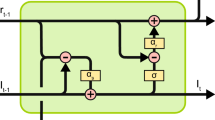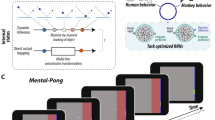Abstract
A behavioural paradigm for learning arbitrary visuo-motor associations established that human observers learn to associate visual objects with their corresponding motor responses faster if the objects follow a temporal rule rather than if they were presented in a random order. Here, we use a simple recurrent network with a back propagation training algorithm adapted to a reinforcement learning scheme. Our simulations fit quantitatively as well as qualitatively to the behavioural results, endorsing the role of temporal context in associative learning scenarios.





Similar content being viewed by others
References
Ackley DH, Littman ML. Generalization and scaling in reinforcement learning. In: Advances in neural information processing systems 2. Morgan Kaufmann; 1990. p. 550–7.
Cleeremans A. Mechanisms of implicit learning: connectionist models of sequence processing. Cambridge:MIT;1993.
Elman JL. Finding structure in time. Cogn Sci. 1990;14:179–211.
Grüning A (2007) Elman backpropagation as reinforcement for simple recurrent networks. Neural Comput. 2007;19(11):3108–31.
Hamid O, Wendemuth A, Braun J. Temporal context and conditional associative learning. BMC Neurosci. 2010;11(1):45. doi:10.1186/1471-2202-11-45. URL:http://www.biomedcentral.com/1471-2202/11/45.
Mandler G, Dean PJ. Seriation: development of serial order in free recall. J Exp Psychol. 1969;81(2):207–15.
Mazzoni P, Andersen RA, Jordan MI. A more biologically plausible learning rule for neural networks. Proc Natl Acad Sci USA. 1991;88(10):4433–7
Miyashita Y, Chang HS. Neuronal correlate of pictorial short-term memory in the primate temporal cortex. Nature. 1988; 331:68–70.
Reber AS. Implicit learning of artificial grammars. J Verbal Learn Verbal Behav. 1967;6(6):855–63.
Reber AS. Implicit learning and tacit knowledge. J Exp Psychol Gen. 1989;118(3):219–35.
Sutton RS, Barto AG. Reinforcement learning: an introduction. Adapt Comput Mach Learn. 1998;Mit Pr.
Werfel J, Xie X, Seung HS. Learning curves for stochastic gradient descent in linear feedforward networks. Neural Comput. 2005;17(12):2699–718.
Yakovlev V, Fusi S, Berman E, Zohary E. Inter-trial neuronal activity in inferior temporal cortex: a putative vehicle to generate long-term visual associations. Nat Neurosci.1998;1:310–7.
Acknowledgments
The authors acknowledge the support provided by the federal state Sachsen-Anhalt with the Graduiertenförderung (LGFG scholarship).
Author information
Authors and Affiliations
Corresponding author
Rights and permissions
About this article
Cite this article
Glüge, S., Hamid, O.H. & Wendemuth, A. A Simple Recurrent Network for Implicit Learning of Temporal Sequences. Cogn Comput 2, 265–271 (2010). https://doi.org/10.1007/s12559-010-9066-z
Received:
Accepted:
Published:
Issue Date:
DOI: https://doi.org/10.1007/s12559-010-9066-z




